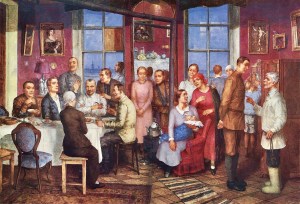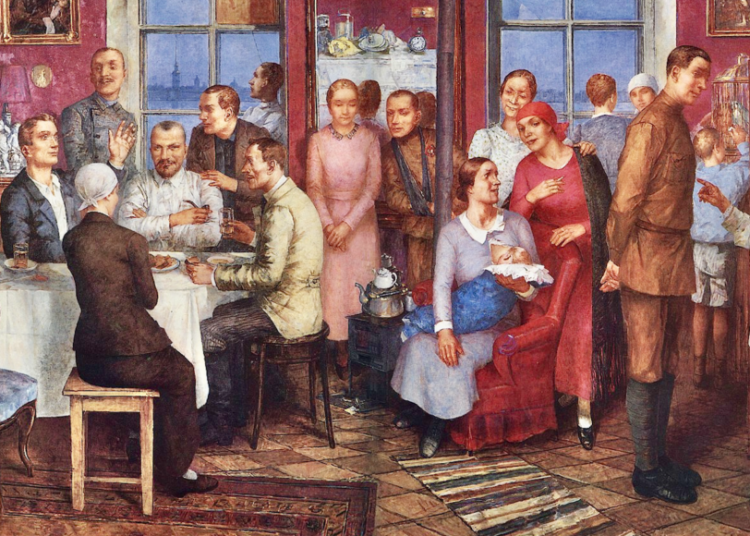C.S. Lewis’ obscure essay, ‘A Note on Jane Austen,’ shows that it is Austen’s humor and humility that captures Lewis’ fancy and that directs us to a Lenten lesson.
 In his rule Saint Benedict advises that each monk should have a holy book to read during Lent. When searching for a holy book, we are not likely to reach for one of Jane Austen’s novels.
In his rule Saint Benedict advises that each monk should have a holy book to read during Lent. When searching for a holy book, we are not likely to reach for one of Jane Austen’s novels.
I took down my copy of Sense and Sensibility a few weeks ago and was not disappointed. At the heart of the story lies a very lenten lesson from Miss Austen, and it is C.S. Lewis, in an obscure essay, who enlightens us.
One always suspected that the bluff and hearty C.S. Lewis would delight in the works of Jane Austen. Her down-to-earth common sense connected with his enjoyment of life’s simple pleasures, as well as his dislike of cant, hypocrisy, and humbug of all kinds. Given a time machine to transport someone to 1950s Oxford, no doubt C.S. Lewis would have been quite happy to welcome Plain Jane Austen to the Bird and Baby to spar with the Inklings. She would have timidly intruded on that male preserve, perhaps introduced by Dorothy Sayers.
The essay in question is ‘A Note on Jane Austen,’ archived in Selected Literary Essays, edited by Walter Hooper, and in the essay it is Austen’s humor and humility that captures Lewis’ fancy and directs us to the Lenten lesson.
Lewis begins the essay by quoting four passages from Austen. In the first from Northanger Abbey, Catherine Morland comes to self-knowledge: facing her foolishness and resolving to behave better in the future. The second quotation is Marianne Dashwood’s bitter self-realization in Sense and Sensibility. The third—from Pride and Prejudice—is Elizabeth Bennett’s brutal enlightenment at the true nature of the scoundrel Wickham, and the final quotation from Emma concerns Emma’s sudden self-knowledge as she realizes how badly she had behaved concerning her friend Harriet.
Lewis points out that each of the four novels turns on the disillusionment of the heroine, or in more positive terms, her enlightenment. In each case, the heroine undergoes the transformation of true repentance. The Authorized Version of the Prodigal Son story says that in the pig pen the son “came to himself.” This profound conversion is at the heart of all great literature and René Girard was convinced that this had also to extend to the novelist himself. He observed, “So the career of the great novelist is dependent upon a conversion, and even if it is not made completely explicit, there are symbolic allusions to it at the end of the novel. These allusions are at least implicitly religious.”
Lewis sees this in Austen. Her own religion was expressed through the polite facade of English society. She would have abhorred the “enthusiasm” of the Methodists, but Lewis sniffs out the religious language Austen uses, especially in the scene of Marianne Dashwood’s disillusionment and enlightenment. Marianne’s selfish sentimentality in her love affair with Willoughby brings on an illness that nearly kills her, and this leads to her remorse and sincere repentance. Lewis observes, “The vocabulary of the passage strikes a note unfamiliar in Jane Austen’s style. It makes explicit, for once, the religious background of the author’s ethical position. Hence such theological or nearly theological words as penitence, amendment, self destruction, my God.”
Marianne’s disillusionment and enlightenment lead to clarity of thought and vision. It is captured in what Lewis recognizes as the “hardness or at least the firmness” of Austen’s thought. He notes her use of abstract nouns: good sense, courage, contentment, fortitude, impropriety, indelicacy, generous candor, blamable distrust, just humiliation, vanity, folly, ignorance, reason. “These are the concepts” he writes, “by which Jane Austen grasps the world.”
Where is the feminine genius in all of this? It is in the fact that the novels are comedies. Jane Austen deals with serious themes lightly. She observes the foolish vanity of her characters with a wry smile and the kind of sharp satirical wit that is feminine through and through. A man writing satire is likely to be sarcastic, overbearing, and cruel. He may deal with such serious themes with a heavy hand, a wordy exposition, or a philosophical speech. A woman dismisses such ponderous sermonizing and scores points with the sly comment, the wicked witticism, and the observation that is damning with faint praise.
In Jane Austen, the satire is never vain or silly, but astringent because of the disillusionment and enlightenment at the heart of her heroines’ stories. In this respect, Austen is reflected in the stories of Flannery O’Connor, who sees the world through the same clear lens of honesty and hard-bitten truth. What Lewis says about Austen could therefore be well spoken about O’Connor: “The hard core of morality and even religion seems to me to be just what makes good comedy possible… unless there is something about which the author is never ironical, there can be no true irony in the work.”
The humor in Jane Austen is linked therefore with humility. Her heroines come to themselves and see the world as it truly is, and this pragmatic vision also sheds light on the pride and prejudice of those around them. As that light shines, we also see things as they are. Our own vanity and egotistical deceptions are brought into the light of day, and if we are graced with even a smidgen of self-awareness, we stop and laugh, and this is a lesson not only for Lent but for every season of the heart.
This essay is an adapted chapter of Dwight Longenecker’s book Reluctant Allies: Essays on Eliot and the Inklings. Visit Fr. Longenecker’s website to read his blog, browse his books, and be in touch: dwightlongenecker.com.
This essay was first published here in February 2023.
The Imaginative Conservative applies the principle of appreciation to the discussion of culture and politics—we approach dialogue with magnanimity rather than with mere civility. Will you help us remain a refreshing oasis in the increasingly contentious arena of modern discourse? Please consider donating now.
The featured image is “Moving party” (1937) by Kuzma Petrov-Vodkin, and is in the public domain, courtesy of Wikimedia Commons.


